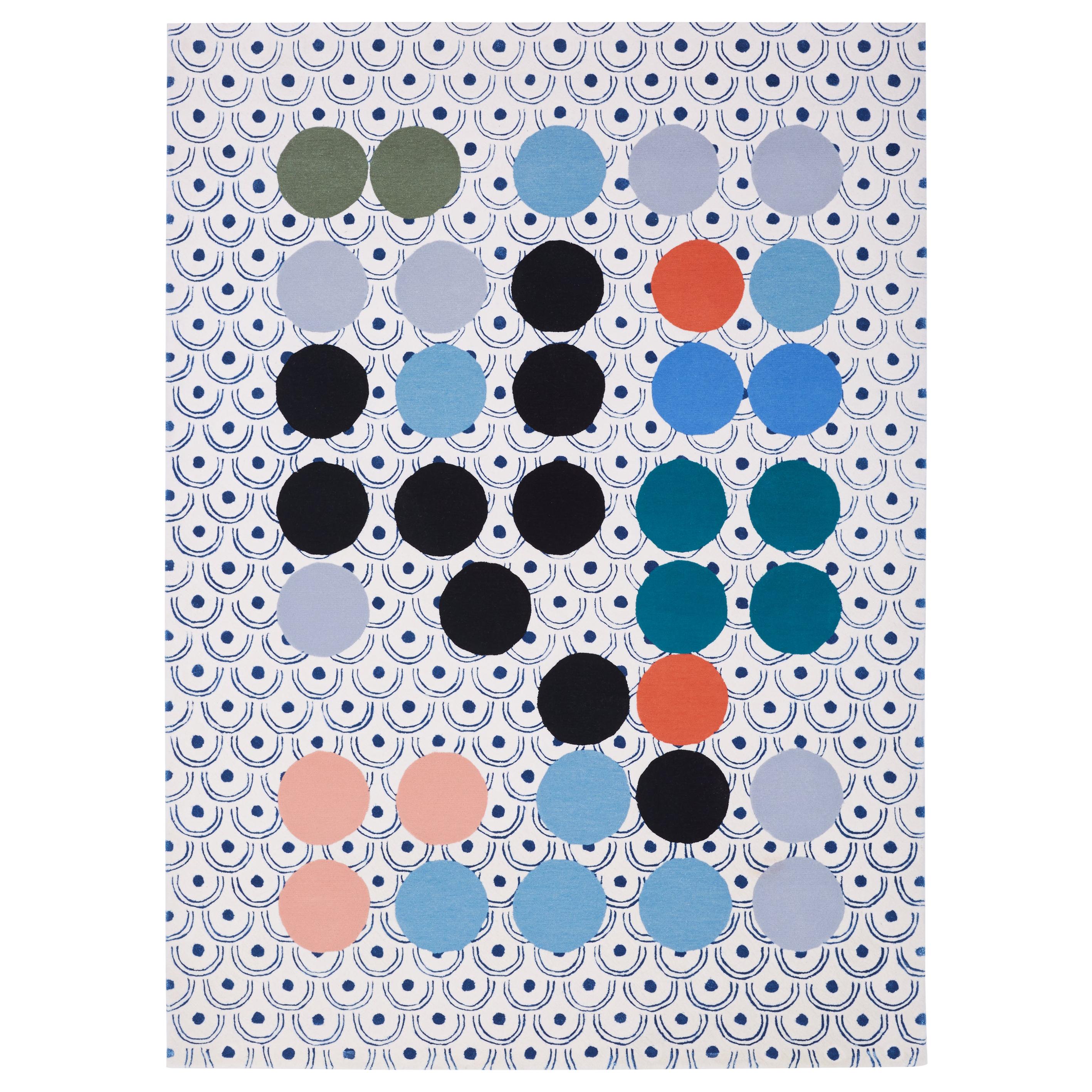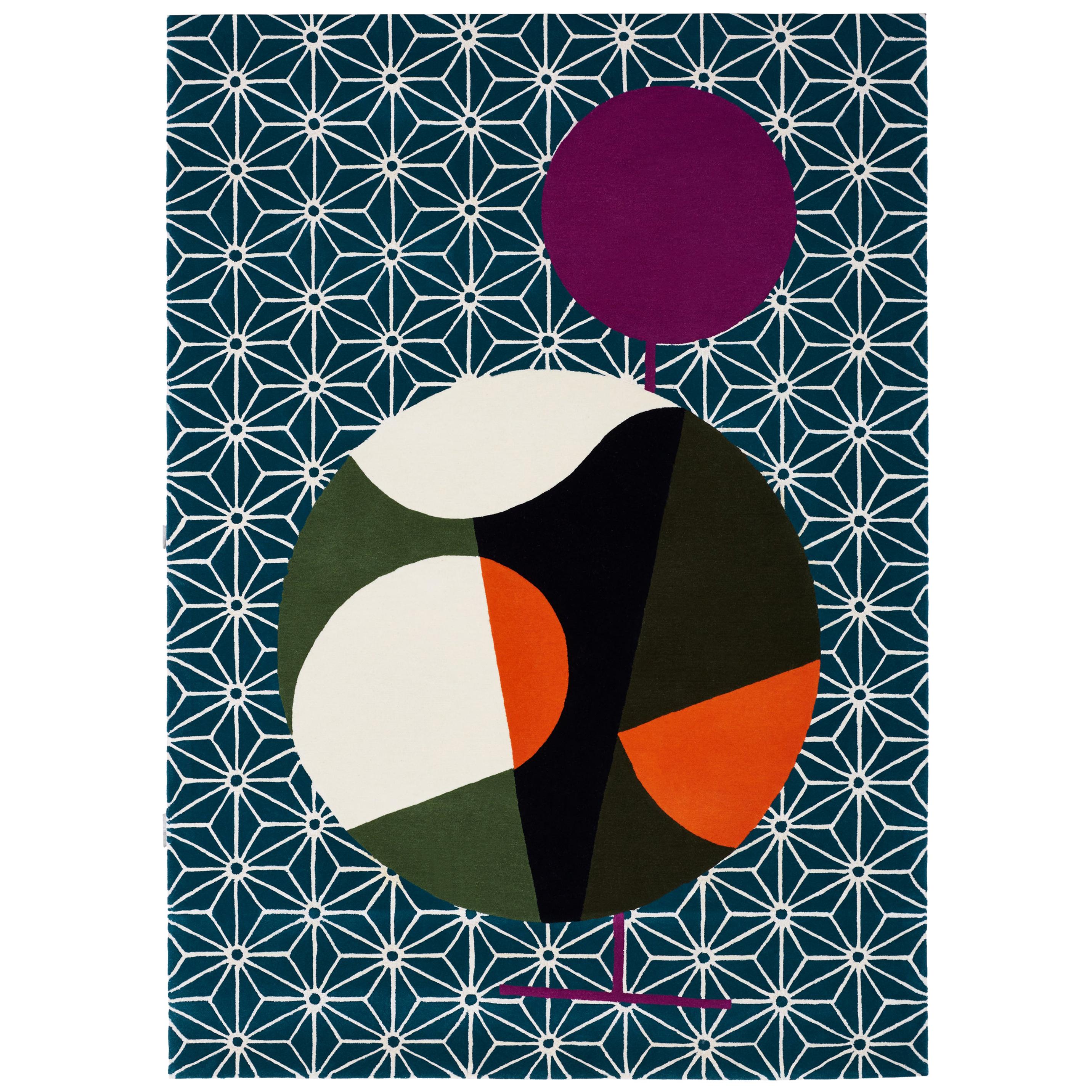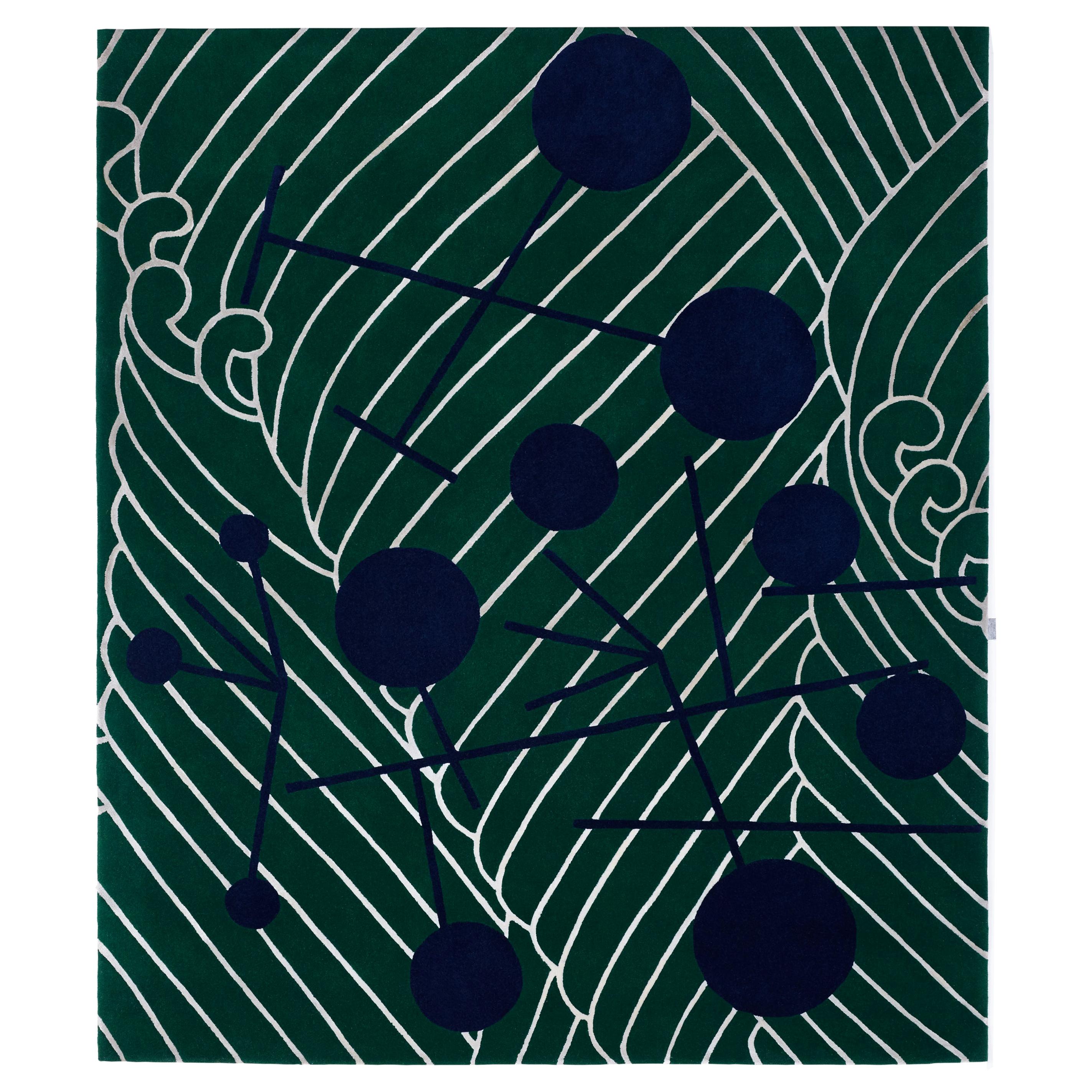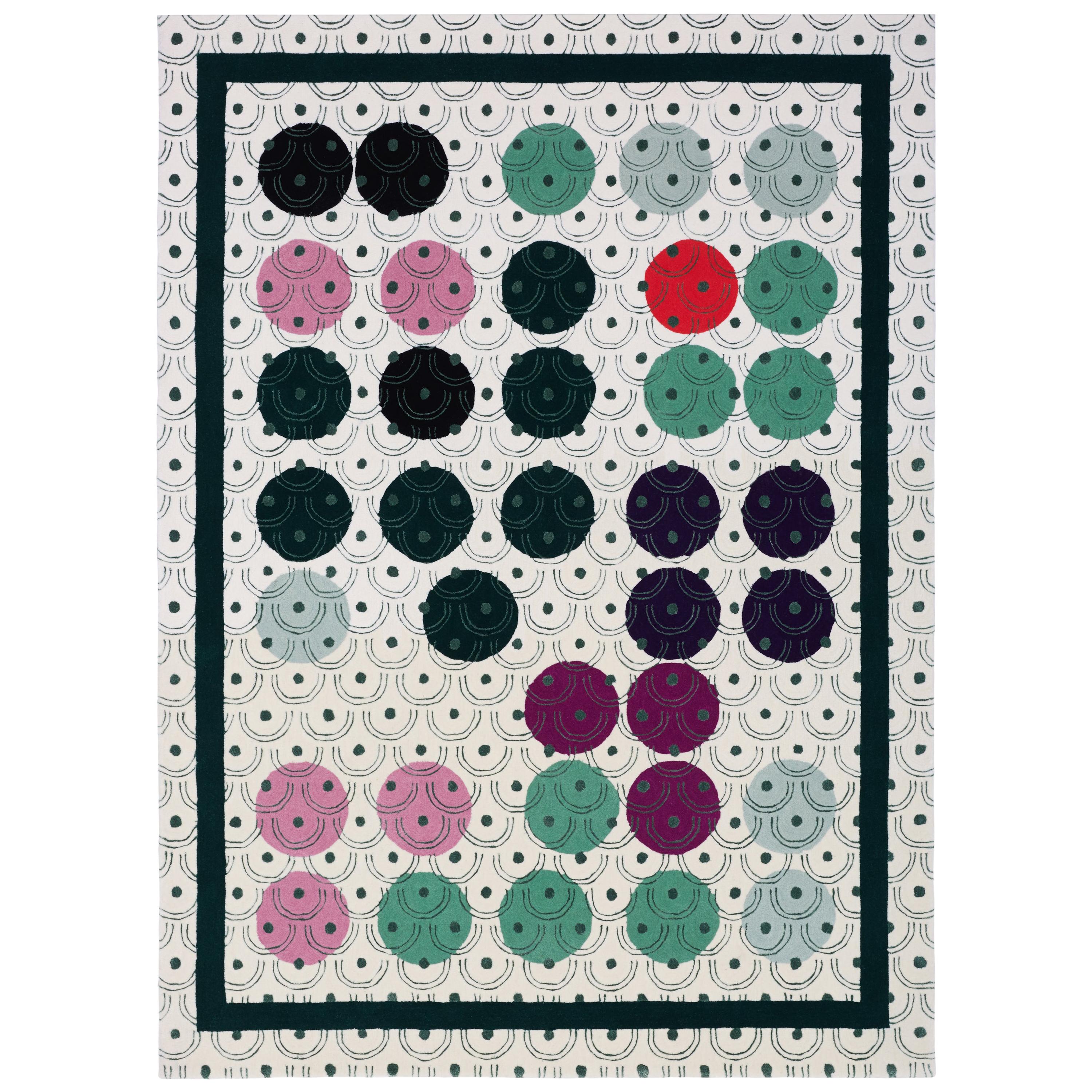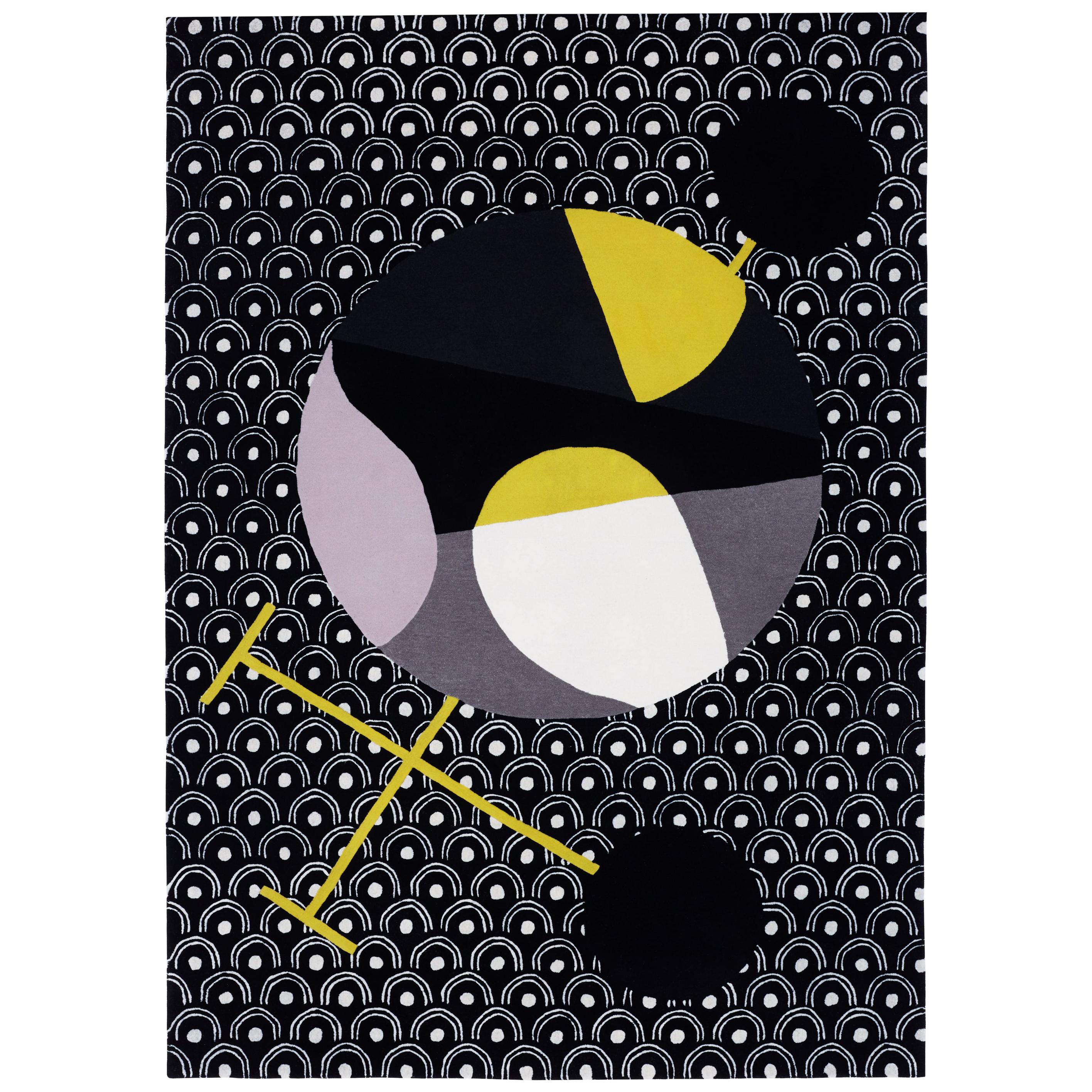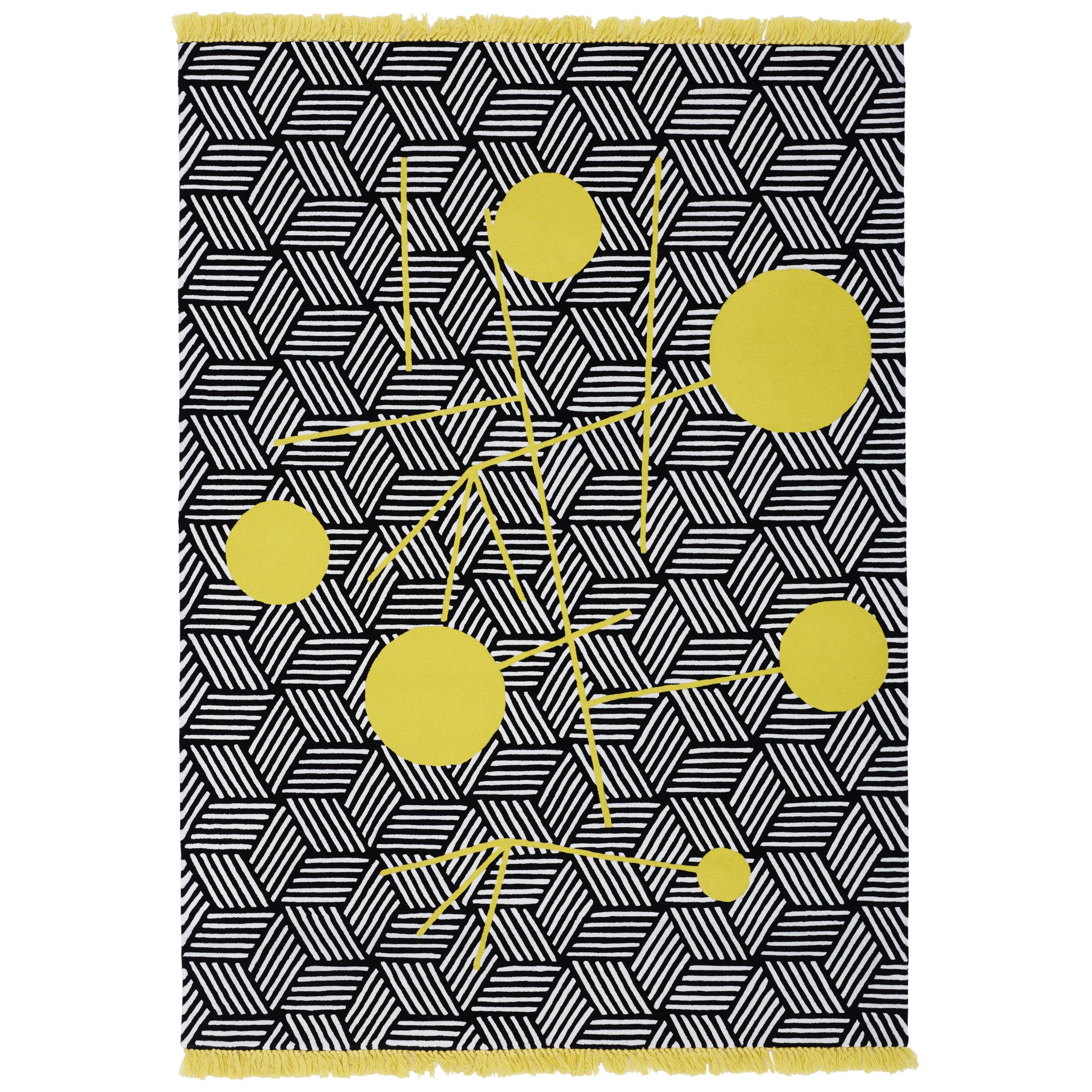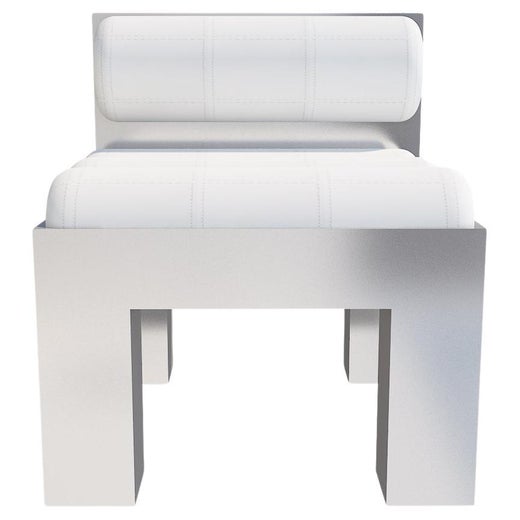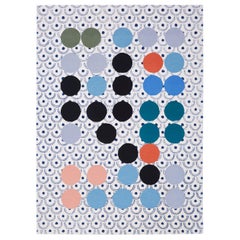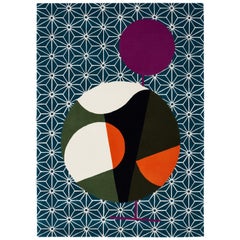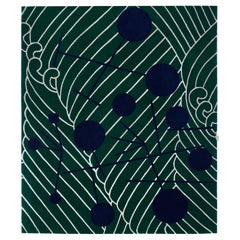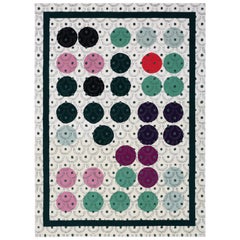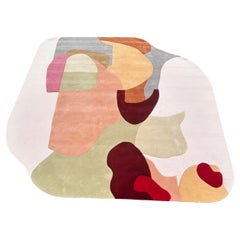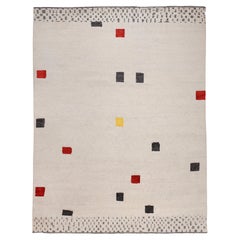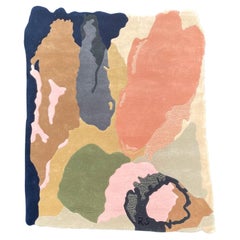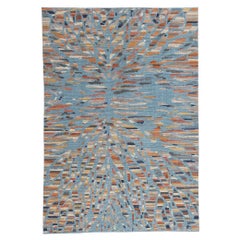Items Similar to Abstract Dadaist Contemporary Rug Inspired by Sophie Taeuber Arp
Want more images or videos?
Request additional images or videos from the seller
1 of 20
Abstract Dadaist Contemporary Rug Inspired by Sophie Taeuber Arp
$4,199.05per item
£3,104.41per item
€3,520per item
CA$5,775.73per item
A$6,420.08per item
CHF 3,365.27per item
MX$78,404.70per item
NOK 42,013.43per item
SEK 39,526.80per item
DKK 26,797.70per item
Quantity
About the Item
Abstract Dadaist contemporary rug inspired by Sophie Taeuber Arp
Artist: Sophie Taeuber Arp
Dimensions: W 170 x D 240 cm
New Zealand wool and silk
Japanese Abstractions is a collection of nine pieces, all designed around the concept of the imaginary trip to Japan of the Dadaist and feminist artist Sophie Taeuber Arp. Each rug is a combination of geometric shapes and traditional Japanese patterns, a result of the unexpected yet poetic encounter between pure abstraction and cultural influences, between West and East.
SOPHIE TAEUBER-ARP
Biography (1889–1929)
Sophie Henriette Gertrud Taeuber was born on January 19, 1889 in Davos-Platz, Switzerland. From 1904 to 1907 she attended the Stauffacher-Schule and the drawing school at the Industrie- und Gewerbemuseum, or the museum for industry and design, in St. Gallen. In 1910 she began her studies at the Lehr- und Versuchsateliers für angewandte und freie Kunst in Munich, a reformed art school that sought to synthesize the visual and applied arts. After an additional semester at the school of applied arts in Hamburg in 1914, her student days came to an end. She joined the Schweizerischer Werkbund in 1915, the same year that she met Hans Arp. Enthused about her work, he encouraged her to devote herself to it even more fully. The artists’ close collaboration resulted in collages, sculptures and textile designs. Sophie Taeuber took lessons in movement arts from Rudolf von Laban, a founder of modern dance. She appeared as a dancer at the Dada-Soirées at the Cabaret Voltaire and the Galerie-Dada. Later on, she choreographed her own pieces. On May 5, 1916, she took over the textile class at the applied arts school in Zurich. In 1918, she also became a member of the artist’s association Das Neue Leben (New Life). At the same time, she undertook the design of stage backdrops and marionettes for Carlo Gozzi’s rendition of the opera König Hirsch. On October 20, 1922, she married Hans Arp. In 1925, Taeuber-Arp was appointed a member of the Swiss jury at the Exposition Internationale des Arts Décoratifs et Industriels in Paris. Her works won prizes and were shown in the International Exhibition of Modern Tapestries in Toledo, Ohio, USA. Sophie Taeuber-Arp and Hans Arp became French citizens in 1926. Through her connections with the Horn brothers, she secured contracts to design the interiors for various buildings, including the Aubette in Strasbourg. In turn, she asked Hans Arp and Theo van Doesburg to collaborate with her on this large-scale project. Around the same time, she had a studio-home built according to her own plans in Clamart, near Paris. Having left her teaching post in Switzerland in 1929, Sophie Taeuber-Arp settled permanently in France. In collaboration with Marcel-Eugéne Cahen, she also realized the renovation and redesign of theParisian Galerie Goemans.
SOPHIE TAEUBER-ARP
Biography (1930–1943)
In Paris, Sophie Taeuber-Arp joined the artists’ group Cercle et Carré and participated in their exhibitions. In 1931 she became a member of the association Abstraction-Création. Her artist friends Theodor and Woty Werner hired her to design the interior of their Paris apartment. A year later, in 1932, she left the Schweizerischer Werkbund. Her visit to the Sztuki Museum in Lodz, which was facilitated by Jan Brzekowski, led to a fruitful artistic exchange between the Polish avant-garde association a.r. and the Parisian artist’s group Abstraction-Création. Sophie Taeuber-Arp participated in various group exhibitions, and often showed her work with Artistes Suisses at the Galerie Vavin and at the Kunsthalle Bern with Hans Arp, Kurt Seligmann, Hans Schiess, and many others. She designed the layout for Anatole Jakovskis’ book Hans Erni, Hans Schiess, Kurt Seligmann, S. H. Taeuber-Arp, Gerard Vulliamy in 1935. Theodor and Woty Werner helped her secure the commission to design the interior of the Bauhaus professor Ludwig Hilberseimer’s Berlin apartment. Her work was shown in the exhibition These, Antithese, Synthese at the Kunstmuseum Luzern and in 1936 in Zeitprobleme in der Schweizer Malerei und Plastik, an exhibition of contemporary Swiss painting and sculpture, at the Kunsthaus Zürich. Additionally, she participated in the Konstruktivisten-Ausstellung, an exhibition of constructivist art, at the Kunsthalle Basel. Sophie Taeuber-Arp founded the international artists’ journal plastique with César Domela, A. E. Gallatin and L. K. Morris in 1937. The same year she joined the Swiss artists’ group Allianz. In 1938, she exhibited at the Exposition internationale du Surréalisme in Paris and at the Exposition of Contemporary Sculpture in London. Her illustrations appeared in Hans Arp’s poetry collection Muscheln und Schirme in 1938 as well. The couple fled from German occupation in 1941 to Grasse, where they stayed with Alberto and Susi Magnelli. A selection of the collaborative drawings made by Taeuber-Arp, Arp, Sonia Delaunay and Magnelli during that visit were published in 1950. In 1941, for the first time since the beginning of the war, Taeuber-Arp was able to visit her family in Switzerland. She returned to see them again the following year, in November 1942. Sophie Taeuber-Arp died on January 13, 1943 of carbon monoxide poisoning in Zurich.
- Dimensions:Width: 66.93 in (170 cm)Length: 94.49 in (240 cm)
- Style:Modern (Of the Period)
- Materials and Techniques:
- Place of Origin:
- Period:
- Date of Manufacture:2020
- Production Type:New & Custom(Current Production)
- Estimated Production Time:11-12 weeks
- Condition:
- Seller Location:Geneve, CH
- Reference Number:1stDibs: LU1219233856462
Galerie Philia
Galerie Philia is an international contemporary sculptural design and art gallery representing emerging and established designers and artists. The gallery is the brainchild of two brothers who share a lifetime passion for art, literature and philosophy. Their distinct academic background sets them apart from their peers, as it sees them following a rhizomatic and transcultural approach in the way they select works. This involves combining elements from multiple cultures in what becomes a network of harmoniously interconnected roots, ultimately revealing the beauty of each unique creation. The gallery’s non-hierarchical curation sits apart from the ephemerality of trends and focuses instead on the true aesthetic quality of the piece – alluring and timeless. Unlike others, Galerie Philia does not focus on a single style – whether minimalist, organic or raw – but rather embraces heterogeneity. The Galerie Philia takes pride in discovering new talents, providing them with multiple international platforms to showcase their latest creations. As well as propelling the newest generation of 21st century collectible design, Galerie Philia also works with internationally known design artists. Galerie Philia has a strong international presence, with galleries in Geneva, New York and Singapore. In addition to their permanent spaces, the gallery organizes temporary group exhibitions and artists residencies in first-class locations around the world.
Made to order dimensions can be ordered
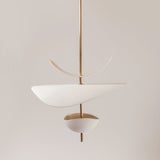
About the Seller
5.0
Recognized Seller
These prestigious sellers are industry leaders and represent the highest echelon for item quality and design.
Diamond Seller
Premium sellers with a 4.7+ rating and 24-hour response times
Established in 2015
1stDibs seller since 2015
5,016 sales on 1stDibs
Typical response time: <1 hour
- ShippingRetrieving quote...Shipping from: Paris, France
- Return Policy
Authenticity Guarantee
In the unlikely event there’s an issue with an item’s authenticity, contact us within 1 year for a full refund. DetailsMoney-Back Guarantee
If your item is not as described, is damaged in transit, or does not arrive, contact us within 7 days for a full refund. Details24-Hour Cancellation
You have a 24-hour grace period in which to reconsider your purchase, with no questions asked.Vetted Professional Sellers
Our world-class sellers must adhere to strict standards for service and quality, maintaining the integrity of our listings.Price-Match Guarantee
If you find that a seller listed the same item for a lower price elsewhere, we’ll match it.Trusted Global Delivery
Our best-in-class carrier network provides specialized shipping options worldwide, including custom delivery.More From This Seller
View AllAbstract Dadaist Contemporary Rug Inspired by Sophie Taeuber Arp
Located in Geneve, CH
Abstract Dadaist contemporary rug inspired by Sophie Taeuber Arp
Artist: Sophie Taeuber Arp
Dimensions: W 170 x D 240 cm
New Zealand wool and silk
Ja...
Category
2010s New Zealand Modern Western European Rugs
Materials
Wool
Abstract Dadaist Contemporary Rug Inspired by Sophie Taeuber Arp
Located in Geneve, CH
Abstract Dadaist Contemporary rug inspired by Sophie Taeuber Arp
Artist: Sophie Taeuber Arp
Dimensions: W 170 x D 240 cm
New-Zealand wool and silk
Ja...
Category
2010s New Zealand Modern Western European Rugs
Materials
Wool
Abstract Dadaist Contemporary Rug Inspired by Sophie Taeuber Arp
Located in Geneve, CH
Abstract Dadaist Contemporary rug inspired by Sophie Taeuber Arp
Artist: Sophie Taeuber Arp
Dimensions: W 170 x D 240 cm
New Zealand wool and silk
Ja...
Category
2010s New Zealand Modern Western European Rugs
Materials
Wool
Abstract Dadaist Contemporary Rug Inspired by Sophie Taeuber Arp
Located in Geneve, CH
Abstract Dadaist contemporary rug inspired by Sophie Taeuber Arp
Artist: Sophie Taeuber Arp
Dimensions: W 170 x D 240 CM
New-Zealand wool and silk
Ja...
Category
2010s New Zealand Modern Western European Rugs
Materials
Wool
Abstract Dadaist Contemporary Rug Inspired by Sophie Taeuber Arp
Located in Geneve, CH
Abstract Dadaist contemporary rug inspired by Sophie Taeuber Arp
Artist: Sophie Taeuber Arp
Dimensions: W 170, D 240 cm
New-Zealand wool and silk
Japanese Abstractions is a collection of nine pieces, all designed around the concept of the imaginary trip to Japan of the Dadaist and feminist artist Sophie Taeuber Arp. Each rug is a combination of geometric shapes and traditional Japanese patterns, a result of the unexpected yet poetic encounter between pure abstraction and cultural influences, between West and East.
SOPHIE TAEUBER-ARP
Biography (1889–1929)
Sophie Henriette Gertrud Taeuber was born on January 19, 1889 in Davos-Platz, Switzerland. From 1904 to 1907 she attended the Stauffacher-Schule and the drawing school at the Industrie- und Gewerbemuseum, or the museum for industry and design, in St. Gallen. In 1910 she began her studies at the Lehr- und Versuchsateliers für angewandte und freie Kunst in Munich, a reformed art school that sought to synthesize the visual and applied arts. After an additional semester at the school of applied arts in Hamburg in 1914, her student days came to an end. She joined the Schweizerischer Werkbund in 1915, the same year that she met Hans Arp. Enthused about her work, he encouraged her to devote herself to it even more fully. The artists’ close collaboration resulted in collages, sculptures and textile designs. Sophie Taeuber took lessons in movement arts from Rudolf von Laban, a founder of modern dance. She appeared as a dancer at the Dada-Soirées at the Cabaret Voltaire and the Galerie-Dada. Later on, she choreographed her own pieces. On May 5, 1916, she took over the textile class at the applied arts school in Zurich. In 1918, she also became a member of the artist’s association Das Neue Leben (New Life). At the same time, she undertook the design of stage backdrops and marionettes for Carlo Gozzi’s rendition of the opera König Hirsch. On October 20, 1922, she married Hans Arp. In 1925, Taeuber-Arp was appointed a member of the Swiss jury at the Exposition Internationale des Arts Décoratifs et Industriels in Paris. Her works won prizes and were shown in the International Exhibition of Modern Tapestries in Toledo, Ohio, USA. Sophie Taeuber-Arp and Hans Arp became French citizens in 1926. Through her connections with the Horn brothers, she secured contracts to design the interiors for various buildings, including the Aubette in Strasbourg. In turn, she asked Hans Arp and Theo van Doesburg to collaborate with her on this large-scale project. Around the same time, she had a studio-home built according to her own plans in Clamart, near Paris. Having left her teaching post in Switzerland in 1929, Sophie Taeuber-Arp settled permanently in France. In collaboration with Marcel-Eugéne Cahen, she also realized the renovation and redesign of theParisian Galerie Goemans.
SOPHIE TAEUBER-ARP
Biography (1930–1943)
In Paris, Sophie Taeuber-Arp joined the artists’ group Cercle et Carré and participated in their exhibitions. In 1931 she became a member of the association Abstraction-Création. Her artist friends Theodor and Woty Werner hired her to design the interior of their Paris apartment. A year later, in 1932, she left the Schweizerischer Werkbund. Her visit to the Sztuki Museum in Lodz, which was facilitated by Jan Brzekowski, led to a fruitful artistic exchange between the Polish avant-garde association a.r. and the Parisian artist’s group Abstraction-Création. Sophie Taeuber-Arp participated in various group exhibitions, and often showed her work with Artistes Suisses at the Galerie Vavin and at the Kunsthalle Bern with Hans Arp, Kurt Seligmann, Hans Schiess, and many others. She designed the layout for Anatole Jakovskis’ book Hans Erni, Hans Schiess, Kurt Seligmann, S. H. Taeuber-Arp, Gerard Vulliamy in 1935. Theodor and Woty Werner helped her secure the commission to design the interior of the Bauhaus professor Ludwig Hilberseimer’s Berlin apartment. Her work was shown in the exhibition These, Antithese, Synthese at the Kunstmuseum Luzern and in 1936 in Zeitprobleme in der Schweizer Malerei und Plastik, an exhibition of contemporary Swiss painting and sculpture, at the Kunsthaus Zürich. Additionally, she participated in the Konstruktivisten-Ausstellung, an exhibition of constructivist art, at the Kunsthalle Basel. Sophie Taeuber-Arp founded the international artists’ journal plastique with César Domela, A. E. Gallatin and L. K. Morris in 1937. The same year she joined the Swiss artists’ group Allianz. In 1938, she exhibited at the Exposition internationale du Surréalisme in Paris and at the Exposition of Contemporary Sculpture in London...
Category
2010s New Zealand Modern Western European Rugs
Materials
Wool
Abstract Dadaist Contemporary Rug Inspired by Sophie Taeuber Arp
Located in Geneve, CH
Abstract Dadaist contemporary rug inspired by Sophie Taeuber Arp.
Artist: Sophie Taeuber Arp
Dimensions: W 170, D 240 cm
New-Zealand wool and silk.
Japanese Abstractions is a collection of nine pieces, all designed around the concept of the imaginary trip to Japan of the Dadaist and feminist artist Sophie Taeuber Arp. Each rug is a combination of geometric shapes and traditional Japanese patterns, a result of the unexpected yet poetic encounter between pure abstraction and cultural influences, between West and East.
Sophie Taeuber-Arp
Biography (1889–1929)
Sophie Henriette Gertrud Taeuber was born on January 19, 1889 in Davos-Platz, Switzerland. From 1904 to 1907 she attended the Stauffacher-Schule and the drawing school at the Industrie- und Gewerbemuseum, or the museum for industry and design, in St. Gallen. In 1910 she began her studies at the Lehr- und Versuchsateliers für angewandte und freie Kunst in Munich, a reformed art school that sought to synthesize the visual and applied arts. After an additional semester at the school of applied arts in Hamburg in 1914, her student days came to an end. She joined the Schweizerischer Werkbund in 1915, the same year that she met Hans Arp. Enthused about her work, he encouraged her to devote herself to it even more fully. The artists’ close collaboration resulted in collages, sculptures and textile designs. Sophie Taeuber took lessons in movement arts from Rudolf von Laban, a founder of modern dance. She appeared as a dancer at the Dada-Soirées at the Cabaret Voltaire and the Galerie-Dada. Later on, she choreographed her own pieces. On May 5, 1916, she took over the textile class at the applied arts school in Zurich. In 1918, she also became a member of the artist’s association Das Neue Leben (New Life). At the same time, she undertook the design of stage backdrops and marionettes for Carlo Gozzi’s rendition of the opera König Hirsch. On October 20, 1922, she married Hans Arp. In 1925, Taeuber-Arp was appointed a member of the Swiss jury at the Exposition Internationale des Arts Décoratifs et Industriels in Paris. Her works won prizes and were shown in the International Exhibition of Modern Tapestries in Toledo, Ohio, USA. Sophie Taeuber-Arp and Hans Arp became French citizens in 1926. Through her connections with the Horn brothers, she secured contracts to design the interiors for various buildings, including the Aubette in Strasbourg. In turn, she asked Hans Arp and Theo van Doesburg to collaborate with her on this large scale project. Around the same time, she had a studio-home built according to her own plans in Clamart, near Paris. Having left her teaching post in Switzerland in 1929, Sophie Taeuber-Arp settled permanently in France. In collaboration with Marcel-Eugéne Cahen, she also realized the renovation and redesign of the Parisian Galerie Goemans.
Sophie Taeuber-Arp
Biography (1930–1943)
In Paris, Sophie Taeuber-Arp joined the artists’ group Cercle et Carré and participated in their exhibitions. In 1931 she became a member of the association Abstraction-Création. Her artist friends Theodor and Woty Werner hired her to design the interior of their Paris apartment. A year later, in 1932, she left the Schweizerischer Werkbund. Her visit to the Sztuki Museum in Lodz, which was facilitated by Jan Brzekowski, led to a fruitful artistic exchange between the Polish avant-garde association a.r. and the Parisian artist’s group Abstraction-Création. Sophie Taeuber-Arp participated in various group exhibitions, and often showed her work with Artistes Suisses at the Galerie Vavin and at the Kunsthalle Bern with Hans Arp, Kurt Seligmann, Hans Schiess, and many others. She designed the layout for Anatole Jakovskis’ book Hans Erni, Hans Schiess, Kurt Seligmann, S. H. Taeuber-Arp, Gerard Vulliamy in 1935. Theodor and Woty Werner helped her secure the commission to design the interior of the Bauhaus professor Ludwig Hilberseimer’s Berlin apartment. Her work was shown in the exhibition These, Antithese, Synthese at the Kunstmuseum Luzern and in 1936 in Zeitprobleme in der Schweizer Malerei und Plastik, an exhibition of contemporary Swiss painting and sculpture, at the Kunsthaus Zürich. Additionally, she participated in the Konstruktivisten-Ausstellung, an exhibition of constructivist art, at the Kunsthalle Basel. Sophie Taeuber-Arp founded the international artists’ journal plastique with César Domela, A. E. Gallatin and L. K. Morris in 1937. The same year she joined the Swiss artists’ group Allianz. In 1938, she exhibited at the Exposition internationale du Surréalisme in Paris and at the Exposition of Contemporary Sculpture in London...
Category
2010s New Zealand Modern Western European Rugs
Materials
Wool
You May Also Like
Abstract Modern Rug by RAG HOME
By RAG home
Located in Jakarta Selatan, ID
Inspired by children's doodles and their first ventures into drawing and coloring, this rug transforms those playful sketches into a large, tactile canvas. A delightful color palette...
Category
2010s Indonesian Modern Chinese and East Asian Rugs
Materials
Wool, Acrylic
$900 / item
'Baako' Contemporary Design Rug by Simone Haug for Alberto Levi Gallery
Located in Milan, IT
In 'Baako', the contemporary Swiss artist Simone Haug continues her exploration of our collective unconscious which she has began with 'Niches'.
The term 'baako' originates from Af...
Category
2010s Indian Tulu Western European Rugs
Materials
Wool
'Mis-Shapes' Contemporary Irregular Abstract Shape Hand Tufted Rug by RAG Home
By RAG home
Located in Jakarta Selatan, ID
'Mis-Shapes'
Contemporary irregular abstract shape hand-tufted rug
A combination of neatness and abstraction. A fluid patterns and shades of primary colors from vibrant to pastel, ...
Category
2010s Indonesian Modern Western European Rugs
Materials
Wool
$1,168 Sale Price / item
20% Off
New Contemporary Abstract Soumak Textured Carpet
Located in Dallas, TX
81129 New Modern Abstract Pakistani Soumak Rug, 08'07 x 12'04. This handwoven wool modern abstract Pakistani Soumak rug is a breathtaking masterpiece that merges traditional weaving ...
Category
21st Century and Contemporary Indian Mid-Century Modern Indian Rugs
Materials
Wool
Contemporary Turkish Abstract Style Room Size Carpet
Located in New York, NY
A modern Turkish abstract style room size carpet handmade during the 21st century.
Measures: 9' 1" x 11' 11"
Category
21st Century and Contemporary Turkish Modern Turkish Rugs
Materials
Wool
Modern Bauhaus inspired rug with geometric design pattern name Dessau 1925.01
By Tuft the World
Located in Philadelphia, PA
Modern Bauhaus inspired rug with geometric design.
Pattern name Dessau 1925.01
- Robo-tufted and hand-finished in Philadlephia, PA
- 100% New Zealand Wool dyed in Georgia
- Design ...
Category
2010s American Mid-Century Modern North and South American Rugs
Materials
Wool
Read More
Galerie Philia Unveils Limited-Edition Designs at Giampiero Tagliaferri’s New L.A. Studio
For the exhibition “Materia Perpetua,” the gallery asked an international group of makers — including Tagliaferri — to explore the possibilities of a surprisingly versatile material: onyx.
Galerie Philia Doesn’t Just Discover Fresh Design Talent — It Grows It
With an impressive slate of international exhibitions, the Geneva-based gallery raises the profiles of emerging designers.
More Ways To Browse
Opera Contemporary Furniture
Jans Of London
Japanese Silk Tapestries
Theo Van Doesburg
Japanese Textile Book
French Marionettes
The Dance Lesson
Opera Backdrop
Wood Beam Table
3 Seat Italian Sofa
Antique Italian Porcelain
Antique Side Table With Shelf
Art Deco Glass Side Tables
Butterfly Ceramics
Cocktail Pedestal Table
Drop Chair
Mexican Wood Coffee Table
Oak Chairs Carved Back
